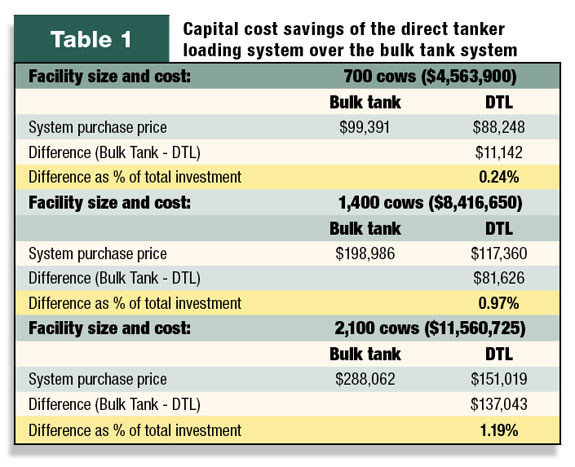The objective of this article is to examine the factors a producer will want to consider when choosing the milk cooling and storage system for the dairy farm. The two systems considered are the traditional, on-farm, bulk tank system and the direct tanker loading (DTL) system that uses glycol chilling plates and loads directly onto the trailer. In the last 50 years, milk has been stored on most dairy farms in a refrigerated bulk tank. From there it was then pumped onto a tanker truck by the milk hauler and taken to the processor. In recent years, larger operations have begun to use direct tanker loading (DTL). With DTL, milk is cooled rapidly and loaded immediately onto a tanker trailer.
The principal audience for this article is those producers seeking information on the feasibility of the direct load option for their operations – generally producers milking 700 or more cows.
As producers, managers and owners contemplate either construction of new large-scale dairies or expansion of existing dairies, a common question is: What is the optimal milk storage system for farms shipping full truckloads of milk? For dairy farms that have the milk volume to fill a milk truck, direct tanker loading is an alternative to the conventional on-farm bulk tank.
This study looked at three hypothetical farm sizes: 700 milking cows, 1,400 milking cows and 2,100 milking cows. Capital and operating cost data were collected from three major dairy equipment manufacturers that service the Upper Midwest.
These three manufacturers’ costs were then “blended” into an average, typical cost. The capital expenses for each size farm were priced for conventional bulk tanks and then also priced for glycol plate chiller systems that load directly into tanker trailers.
Significance
Milk storage and cooling systems are a significant capital investment for the dairy producer. The system of milk storage has a definite impact on the transportation charges, too.
The capital equipment costs for cooling and storage can easily range from 2 to 5 percent of the total initial investment. The annual cooling costs typically run close to 25 percent of the producer’s total electricity charges. Depending on the specific situation, DTL farms may have higher hauling costs, due to the necessity of having a trailer on-site at all times.
Considerations affecting all farms
A variety of issues influence a producer’s choice of milk storage system. Some have cost implications while others involve marketing and management factors. The choice of system should not be made using cost factors alone, but in consideration with other realities.
Marketing considerations
Perhaps the foremost consideration for the milk storage/cooling system is the local milk market. Some markets (and states) simply do not accept direct loads. In such a market, any consideration of direct loading is purely hypothetical.
Other markets accept direct loads on a conditional basis. Still others have no limitation at all on direct loading. Thus, the first step is to have a clear understanding of requirements concerning milk handling for the producer’s actual milk market.
Management considerations
Transportation is a key component in a direct load system. Depending upon the milk market, the producer may be working with contract haulers or company haulers or provide his own trucks and drivers.
Success of the DTL system is critically dependent on a capable trucking system. With the direct load system, a tanker absolutely must arrive on time at the farm. If the truck isn’t on time, then milk will be going into the waste lagoon.
Another management challenge with the DTL system is the whole issue of accurate sampling of the load. Custody of the milk sample can also present some challenges. In most markets, the dairy producer is paid based on the components of the milk. With the DTL system, an accurate sample can be a challenge to obtain.
Tankers do not have built-in agitation, which can make accurate sampling a problem. A question to be addressed in the planning process is where the tanker will be sampled and how – requirements will also vary with the state and the market.
These issues are some of the preliminary considerations a producer would want to address when investigating direct tanker loading. This study will explore those and other issues to provide guidance to a producer deliberating on the choice of system optimal for his farm.

In visiting with the owners of several large herds, when asked why they selected a DTL system, a frequently heard response was the reduction of wash water used.
DTL systems do not require the routine washing of bulk tanks and therefore reduce the amount of wash water that goes in the lagoon.
By far, the most frequent comment was “reduced capital cost;” however, after comparing total systems cost, the capital savings were not simply a matter of removing the cost of the tank. (See Table 1 )
Discussion and recommendations
The results in Table 1 demonstrate some significant points. The actual difference in capital costs between the two systems (DTL and bulk tanks) range from 0.24 percent to 1.19 percent of the total facility construction cost. This is contrary to most producers’ expectations.
Typically, producers assume the capital costs for a DTL system will be much less than for a bulk tank system since the cost of the bulk tanks is eliminated.
The criteria used for the 700-cow farm for this project is not very realistic – most farms of this size would have two bulk tanks. Adding a second bulk tank would make the cost of ownership more closely resemble the costs listed for the 1,400-cow farm.
Because the overall cost of the two systems are so close, one can expect the peripheral and non-economic issues may be much more influential on each producer’s decision. We’ll take a look at some of the other considerations in another article. PD
References omitted due to space but are available upon request to editor@progressivedairy.com .

Earl D. Biggers
DRMS Manager of
Price Risk Management
Dairy Farmers of America
ebiggers@dfamilk.com






